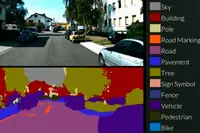 Researchers from the University of Cambridge are developing technologies which use deep learning techniques to help machines to recognise their location and surroundings. The systems could be used for the development of driverless cars and autonomous robotics.
Researchers from the University of Cambridge are developing technologies which use deep learning techniques to help machines to recognise their location and surroundings. The systems could be used for the development of driverless cars and autonomous robotics.
The systems can identify a user’s location and orientation in places where GPS does not function, and identify the various components of a road scene in real time on a regular camera or Smartphone, performing the same job as sensors costing tens of thousands of pounds.
The first system, called SegNet, can take an image of a street scene it hasn’t seen before and classify it, sorting objects into 12 different categories – such as roads, street signs, pedestrians, buildings and cyclists – in real time. It can deal with light, shadow and night-time environments, and currently labels more than 90% of pixels correctly. Previous systems using expensive laser or radar based sensors have not been able to reach this level of accuracy while operating in real time.
For the driverless cars currently in development, radar and base sensors are expensive, often costing more than the car itself. In contrast with expensive sensors, which recognise objects through a mixture of radar and LIDAR, SegNet learns by example – it was ‘trained’ by a group of undergraduate students, who manually labelled every pixel in each of 5000 images, with each image taking about 30 minutes to complete. Once the labelling was finished, the researchers then took two days to ‘train’ the system before it was put into action.
“It’s remarkably good at recognising things in an image, because it’s had so much practice,” said Alex Kendall, a PhD student in the Department of Engineering. “However, there are a million knobs that we can turn to fine-tune the system so that it keeps getting better.”
The system is not yet at the point where it can be used to control a car or truck, but it could be used as a warning system, similar to the anti-collision technologies currently available on some passenger cars.
“Vision is our most powerful sense and driverless cars will also need to see,” said Professor Roberto Cupola, who led the research. “But teaching a machine to see is far more difficult than it sounds.”
As children, we learn to recognise objects through example – if we’re shown a toy car several times, we learn to recognise both that specific car and other similar cars as the same type of object. But with a machine, it’s not as simple as showing it a single car and then having it be able to recognise all different types of cars. Machines today learn under supervision: sometimes through thousands of labelled examples.
There are three key technological questions that must be answered to design autonomous vehicles: where am I, what’s around me and what do I do next. SegNet addresses the second question, while a separate but complementary system answers the first by using images to determine both precise location and orientation.
The localisation system designed by Kendall and Prof Cupola runs on a similar architecture to SegNet, and is able to localise a user and determine their orientation from a single colour image in a busy urban scene. The system is said to be more accurate than GPS and works in places where GPS does not, such as indoors, in tunnels, or in cities where a reliable GPS signal is not available.
It has been tested along a kilometre-long stretch of King’s Parade in central Cambridge, and it is able to determine both location and orientation within a few metres and a few degrees.
The localisation system uses the geometry of a scene to learn its precise location, and is able to determine, for example, whether it is looking at the east or west side of a building, even if the two sides appear identical.
“In the short term, we’re more likely to see this sort of system on a domestic robot – such as a robotic vacuum cleaner, for instance,” said Prof Cupola. “It will take time before drivers can fully trust an autonomous car, but the more effective and accurate we can make these technologies, the closer we are to the widespread adoption of driverless cars and other types of autonomous robotics.”
Author
Tom Austin-Morgan
Source: www.newelectronics.co.uk
